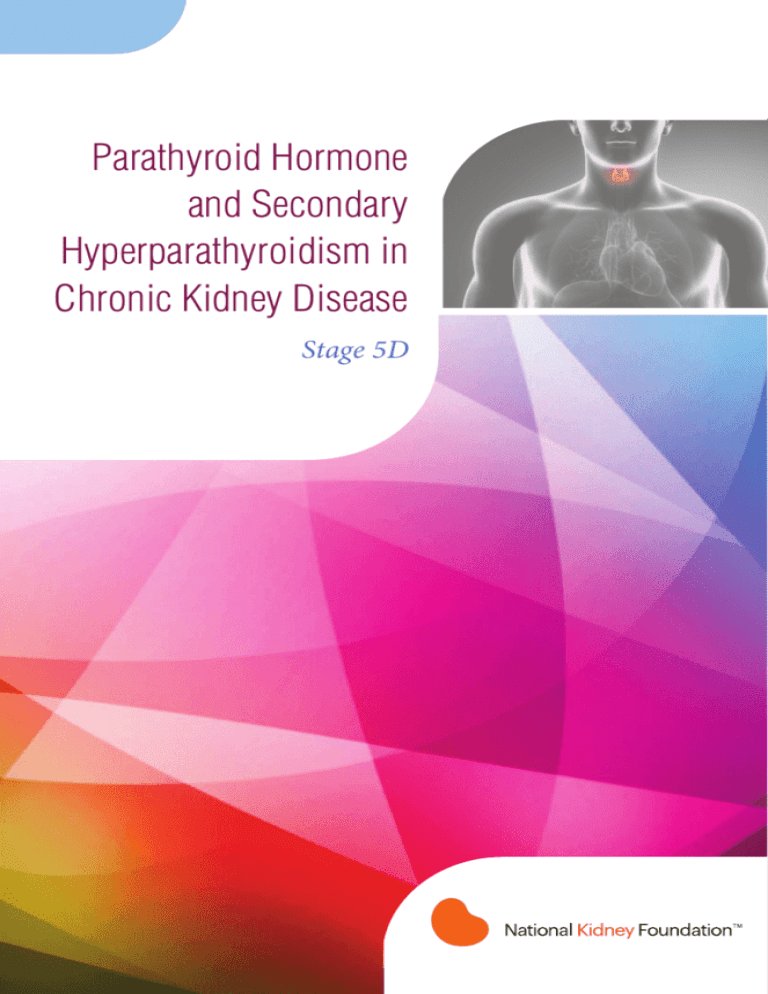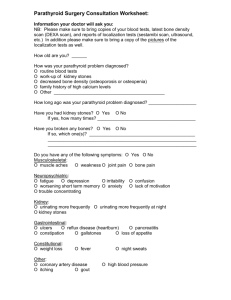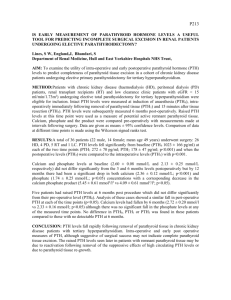
Parathyroid Hormone
and Secondary
Hyperparathyroidism in
Chronic Kidney Disease
Stage 5D
Background
Chronic kidney disease (CKD) affects 14.5% of the U.S. population1 with a host of
biochemical and clinical abnormalities, including chronic kidney disease-mineral and bone
disorder (CKD-MBD) and renal osteodystrophy (ROD).2 CKD-MBD refers to the clinical
syndrome encompassing mineral, bone, and vascular calcification abnormalities that develop
as complications of CKD, whereas ROD is currently used to describe the bone pathology
of CKD according to these parameters found on biopsy: bone turnover, mineralization, and
volume.2 Figures 1 and 2 depict the diagnostic spectrum of CKD-MBD and ROD, respectively.
Figure 1. Chronic kidney disease-mineral and bone disorder (CKD-MBD)3
Bone
Abnormalities
Laboratory
Abnormalities
CVD
Fractures
Mortality
Vascular
Bone
Complications
Abnormalities
Adapted from Moe SM, et al. Advances in Chronic Kidney Dis. 2007
Figure 2. Renal osteodystrophy2
HIGH
MILD
HPT
LOW
AL
MUO
TURNOV
RM
IN AL
ER
AL
I
M
AB
LOW
NO
ZA
AD
BONE
VOLUME
NO
TI
ON RM
OM
OF
ER
HIGH
Adapted from: Moe SM, et al. Kidney Int. 2006
AD = adynamic bone disease; Mild HPT = Mild hyperparathyroid-related disease;
MUO = mixed uremic osteodystrophy; OF = osteitis fibrosa or advanced hyperparathyroid-related
disease; OM = osteomalacia.
2
The gold standard for diagnosing bone disease in CKD is bone biopsy, but this is not feasible
for the majority of patients. Without a biopsy, however, the clinician should evaluate trends
in biochemical markers in order to help guide treatment, but only as part of an integrated
and comprehensive assessment. Clinical practice guidelines recommend that, in patients
with CKD stage 5D, either serum parathyroid hormone (PTH) or bone-specific alkaline
phosphatase can be used to evaluate bone disease because markedly high or low values
predict underlying bone turnover.4 The biochemical abnormalities of CKD-MBD may begin
in CKD stage 3, but the rate and severity of these changes are highly variable among
patients. For this reason, it is strongly recommended that monitoring serum levels of calcium,
phosphorus, PTH, and alkaline phosphatase begin at CKD stage 3, and in children at CKD
stage 2.4
The Role of PTH in Secondary Hyperparathyroidism
(secondary HPT)
Secondary HPT manifests as one of two types of renal osteodystrophy: either a high
turnover state known as osteitis fibrosa, or, in combination with low bone turnover, known as
mixed uremic osteodystrophy. The burden of disease caused by osteitis fibrosa and mixed
disease includes: marrow fibrosis that can exacerbate the anemia of CKD; abnormal bone
mineralization; bone pain; myopathy and muscle weakness; spontaneous tendon rupture;
pruritis; fractures; and vascular calcification.5
The development of secondary HPT results from many factors, including deficiency of
calcitriol, retention of phosphorus, a decrease in the activation of the calcium-sensing
receptor (CaR) in the parathyroid gland, and skeletal resistance to the calcemic effect of PTH.
As kidney function declines, so does phosphorus excretion, thus causing plasma phosphorus
levels to rise while plasma calcium and calcitriol levels decrease. A reduction in calcitriol also
contributes to a reduction in intestinal calcium absorption. All of these factors contribute to
the development of hypocalcemia, which is the impetus for an increased production of PTH.5
More recently, fibroblast growth factor-23 (FGF-23), which increases early in the course
of CKD possibly as a consequence of phosphorus retention, has been found to suppress
calcitriol synthesis, in turn leading to increased PTH.6 Figure 3 is a schematic depiction of the
pathogenesis of secondary HPT.
Aside from the negative skeletal effects of secondary HPT, soft tissue calcification can occur
in other body tissues, including the skin and subcutaneous tissue, cornea and conjunctiva,
muscle, lung, gastrointestinal tract, and cardiovascular system. Calcification of cardiac tissue
can affect the myocardium, the conduction system, and valves, and thus may cause adverse
cardiovascular events.8 Calcification of the aortic and/or mitral valve is quite common in adults
receiving maintenance hemodialysis, with a prevalence of 2.5-5.0-fold greater as compared
with non-hemodialysis patients with suspected and documented coronary artery disease.9
Cardiac calcification may also cause myocardial fibrosis and left ventricular dysfunction, which
can culminate in heart failure, or when it involves the electrical conduction system, cardiac
arrhythmias may result.8 Left ventricular hypertrophy has been identified as an independent
risk factor for morbidity and mortality in the dialysis population.10,11 Secondary HPT has
also been implicated in causing severe pruritis which has been shown to improve after
parathyroidectomy.12
3
Figure 3. Pathogenesis of abnormalities in mineral metabolism and bone disease in CKD7
Reduced GFR
Reduced action of
1,25(OH)2D
Vitamin D-resistant
state
Phosphate
reduction
Normal or low
blood levels of
1,25(OH)2D
Interference with
production of
1,25(OH)2D
by kidneys
Increased need
for vitamin D
Relative or
absolute deficiency
of 1,25(OH)2D3
Decreased
expression
of VDR
in parathyroid
Decreased
intestinal
absorption of Ca
Skeletal resistance to
PTH action
Hypocalcemia
Secondary
hyperparathyroidism
Rickets or
osteomalacia
Bone resorption
(osteitis
fibrosa cystica)
Reprinted with permission by KDOQI. Am J Kidney Dis. 2003.
4
Decreased
expression
of Ca-sensing
receptor in
parathyroid
Based upon estimations of the prevalence of secondary HPT in the United States, and the cost
of treating CKD comorbidities, Joy et al had calculated back in 2007 that between 2.0 and
4.7 million people with CKD had elevated PTH levels and were candidates for treatments that
would cost between $52 billion and $122 billion dollars per year.13-16 With the prevalence of
CKD at 14.5% of the population, these numbers have likely increased.
Although secondary HPT is an important complication of CKD with significant burdens on
health and financial resources, it remains under-recognized and under-diagnosed at earlier
stages of CKD.13 Because it is more often detected in advanced CKD, severe secondary
HPT may be resistant to dietary/dialytic/pharmacological therapy and may persist following
transplantation.17 See Figure 4 for the prevalence of secondary HPT with decreasing
glomerular filtration rate (GFR).
Figure 4. Prevalence of abnormal serium calcium, phosphorus, and intact PTH by GFR16
100
Calcium < 8.4 mg/dL
Phosphorus > 4.6 mg/dL
Intact PTH > 65 pg/mL
Patients (%)
80
60
40
20
0
80
(n = 61)
79-70
69-60
(n = 117) (n = 230)
59-50
49-40
39-30
(n = 396) (n = 355) (n = 358)
29-20
(n = 204)
< 20
(n = 93)
GFR Level (mL/min)
Adapted from: Levin A, et al. Kidney Int. 2007
5
Evaluating and Monitoring PTH Levels
Severe secondary HPT is associated with morbidity and mortality in patients with CKD stages
3-5D. Observational studies consistently report an increased relative risk of death in CKD
stage 5D patients who have PTH values at the extremes (less than 2 or greater than 9 times the
upper normal limit of the assay). Progressive increases of PTH should be avoided and marked
changes in PTH levels should trigger a response to avoid a future result outside the range.17
Monitoring trends is important for the detection and treatment of CKD-MBD.4
Establishing narrow target ranges for serum intact PTH is difficult because: 1) studies
demonstrate that the median intact PTH increases and the range widens with progressive
CKD; 2) there are methodological problems with the measurement of PTH because assays
differ in their measurement of accumulating PTH fragments and there is inter-assay and
biological variability (see the section “Overview of PTH Assays”); and 3) the predictive value of
PTH for underlying bone histology is poor when PTH values are between approximately 2 and
9 times the upper normal laboratory range according to the assay used.17
In CKD stage 5D, it is suggested that PTH be maintained at approximately 2 to 9 times the
upper normal limit for the particular assay. If PTH changes markedly in either direction within
this range, a response is warranted to avoid progression to levels outside this range. This PTH
range corresponds to approximately 130-600 pg/mL (depending on the assay).4
Clinicians should be aware that certain populations, such as blacks with CKD, have higher
PTH levels.18-20 Bone turnover is also lower in blacks across a wide range of PTH values as
compared to whites, thus suggesting PTH resistance in the black population.18 This finding
is especially important in light of associations between low bone volume and cardiovascular
calcification in CKD stage 5D patients.21
In patients with CKD stage 5D, it is reasonable to base the frequency of PTH monitoring
on the presence and magnitude of abnormalities and rate of progression of CKD.
Reasonable monitoring intervals: at least every 3 to 6 months with the goal to maintain PTH
at approximately 2 to 9 times the upper normal limit for the particular assay. If PTH changes
markedly in either direction within this range, a response is warranted to avoid progression to
levels outside the range.4
Overview of PTH Assays
PTH is an 84 amino acid peptide that is cleaved both within the parathyroid gland and after
secretion into the N-terminal, C-terminal, and mid-region fragments. There has been a
progression of increasingly sensitive assays developed over the past few decades to measure
PTH (Figure 5), but it was the second generation assay, or “intact PTH” assay that improved
the detection of full-length (active) PTH molecules. For this reason, it is the type of assay most
widely used today. Recent data, however, demonstrates that the intact assay also detects
“N-truncated” fragments (such as 7-84 PTH) that have been shown to exert effects opposite
to those of 1-84.22 And unfortunately, assay kits from different manufacturers measure varying
types and amounts of these circulating fragments, leading to inconsistent results.17
6
The previously recommended target PTH levels of 150-300 pg/mL were arrived at between
the late 1980s to the 1990s using the Nichols Allegro Intact PTH assay, which was the
reference for PTH measurement until early 2006. But since then, inter-method variability has
been shown to produce significantly different concentrations. In addition, most assays have
been calibrated against synthetic 1-84 PTH from different sources.22 Addressing the need
for 1-84 PTH standardization, The World Health Organization (WHO) Expert Committee on
Biological Standardization (ECBS) recently reported a preparation of recombinant human 1-84
PTH to serve as the international standard, known as 95/646.23 But even with a new standard,
PTH concentrations will vary and it is recommended that clinical laboratories inform clinicians
of the actual assay method in use and report any change in methods, sample source (plasma
or serum), and handling specifications to facilitate appropriate interpretation of biochemical
data.17
The use of correction factors to overcome the inter-method variability of PTH measurement
is not the ultimate solution, but may be considered as a pragmatic approach to minimize
the problem. It does not take into account the variable proportions of 1-84 PTH versus PTH
fragments and the various cross-reactions for 7-84 PTH from one second-generation assay to
another.22
Table 1. P
roposed correcting factors for PTH measurements. Division of measured PTH
value by the indicated correction factor results in a PTH value roughly equivalent to
a value that would be measured by the Nichols Allegro™ Intact PTH assay.22
Assay Kit
Correction Factor
Bayer PTH Advia Centaur™
No Correction
Access Intact PTH™
(Beckman Coulter)
No Correction
Roche Elecsys™ PTH
No Correction
Schering CisBio™ ELSA
No Correction
Scantibodies Total Intact PTH
No Correction
Architect™ PTH (Abbott)
1.3
Beckman Coulter PTH IRMA
1.2
DiaSorin Intact PTH IRMA
0.55
LIAISON N-tact PTH
0.90
Scantibodies Ca-PTH IRMA
(the only third-generation assay)
0.55
DPC Immulite 2000™, serum
No Correction
DPC Immulite 2000™, plasma
1.25
7
Figure 5. PTH assays. The figure shows the entire parathyroid hormone
molecule, composed of 84 amino acids.24
FIRST-generation PTH assays
Mid/C-PTH RIA
N-PTH RIA
1
34
84
Second-generation PTH assays
Third-generation PTH assays
Moe SM, Sprague SM. Chapter 52: Mineral bone disorder in chronic kidney disease. In: Brenner and
Rector's The Kidney, 8th ed. WB Saunders Company. Philadelphia, PA, 2007
Mid/C-PTH = mid/carboxyl-terminus of parathyroid hormone; N-PTH = amino-terminus
of parathyroid hormone; PTH = parathyroid hormone; RIA = radioimmunoassay
Several commercial assays provide results that are numerically quite similar to those observed
using the Nichols Allegro Intact PTH assay, as reported by Souberbielle et al. These include
the Bayer PTH Advia Centaur™, Scantibodies Total Intact PTH, and Roche Elecsys™ iPTH.22
For several other assays, a correction factor can be applied to compare the values from each
assay with those determined by the Nichols Allegro Intact PTH assay. It should be noted,
however, that a reference range of values that corresponds with normal bone pathology has
not been determined for any of the PTH assays currently available as was done in the past with
the Nichols Allegro Intact PTH assay.22
The following clinical factors that influence PTH results must also be considered, especially
those for which the clinician does have some control: 1) uncontrollable intra-individual
biological variation reflects each person’s unique biochemical makeup, homeostatic
set point, and presence of disease25; 2) uncontrollable pre-analytic variation caused
by variations in body mass index; age; race; calcium, phosphorus, and vitamin D status26;
dialysis history (number of months or years on dialysis) 27; glomerular filtration rate; and stage
of CKD26; and 3) controllable pre-analytic variation of samples achieved by consistency
in exclusively obtaining either serum or plasma specimens; maintaining proper temperature
during storage and shipping; adhering to recommended time intervals between storage and
analysis; adhering to recommended time limits between freezing and analysis; adhering to
proper procedures for collecting, processing, shipping, and storing samples as described
by the test manufacturer26,28; preventing sample hemolysis and/or contamination by
standardizing collection procedures; and implementing quality assurance programs.29,30
8
Summary
Despite the limitations discussed, PTH is still considered a useful indicator in managing
secondary HPT. Encouragingly, experts suggest that it will be possible to improve the
comparability of PTH results because the new international standard 95/646 for PTH (1-84)
is available for calibration, and because improvements in mass spectrometry could lead to the
development of a reference measurement procedure for PTH.31 While these measures are
being refined, experts agree on interim strategies to reduce error in clinical classification:
• When formulating a diagnosis, the clinician should use an integrated and comprehensive
assessment that includes sufficient laboratory data to recognize trends over time rather
than isolated data points. In patients with CKD stages 3-5D, it is recommended that
decisions be based on trends rather than a single laboratory value, taking into account all
available CKD-MBD assessments.4
• Consider that all types of bone turnover can be found in a broad range of PTH levels26,32,
so it is crucial to closely monitor trends in alkaline phosphatase, calcium, phosphorus, and
vitamin D, and assess patients accordingly.7,17
• Obtain all lab information regarding the PTH assay and related standards for specimen
collection, handling, and shipping. Remain up to date with any changes in these
procedures and create a standardized lab protocol and quality assurance program for
your facility. Correction of some measurement kits can be considered, though a common
standard is not yet available.22 Be aware that “systematic” unidirectional trends observed
in the majority of patients in a single center should prompt suspicion that the central
laboratory may have changed the assay.17
• Test PTH at similar times during the day and week to reduce the influence of diurnal
variations, and in order to decrease inter-assay variability, the same assay should be used
for monitoring changes over time.4
• Control pre-analytic variation of samples by:
Maintaining consistency by exclusively obtaining either serum or plasma
specimens, depending upon assay specifications26,31
Maintaining proper temperature during storage and shipping26
Adhering to the recommended time limits between sample collection, freezing, and
analysis26
Adhering to proper procedures for collecting, processing, shipping, and storing
samples as described by test manufacturer26,28
Preventing sample hemolysis and/or contamination by standardizing collection
procedures and implementing quality assurance programs to achieve proficiency29,30
• Evaluate the role of malnutrition in relative PTH deficiency5
• Use assay-specific targets for CKD patients33
• Investigate known specific assay interferences (eg, high doses of biotin for the
treatment of diabetic peripheral neuropathy can interfere with immunoassays that use
streptavidin-biotin interactions)34
9
Bibliography
1.
US Renal Data System. USRDS 2011 Annual Data Report: Atlas of Chronic Kidney Disease
and End-Stage Renal Disease in the United States. Bethesda, MD: National Institutes of
Health, National Institute of Diabetes and Digestive and Kidney Diseases; 2011.
2.
Moe SM, Drüeke T, Cunningham J, et al. Definition, evaluation, and classification of renal
osteodystrophy: a position statement from Kidney Disease: Improving Global Outcomes
(KDIGO®). Kidney Int. 2006;69:1945-1953.
3.
Moe SM, Drüeke T, Lameire N, Eknoyan G. Chronic kidney disease-mineral bone disorder:
a new paradigm. Adv in Chronic Kid Dis. 2007;14:3-12.
4.
Uhlig K, Berns, JS, Kestenbaum B, et al. KDOQI U.S. commentary on the 2009 KDIGO
clinical practice guideline for the diagnosis, evaluation, and treatment of chronic kidney
disease-mineral and bone disorder (CKD-MBD). Am J Kidney Dis. 2010;55:773-799.
5.
Felsenfeld A, Silver J. Pathophysiology and clinical manifestations of renal osteodystrophy.
In: Olgaard K, ed. Clinical guide to bone and mineral metabolism in CKD. New York, NY:
National Kidney Foundation; 2006:31-41.
6.
Ketteler M, Petermann AT. Phosphate and FGF 23 in early CKD: on how to tackle an
invisible foe. Nephrol Dial Transplant. 2011;26:2430-2432.
7.
Kidney Disease Outcomes Quality Initiative (KDOQI). KDOQI clinical practice guidelines
for bone metabolism and disease in chronic kidney disease. Am J Kidney Dis.
2003;42(suppl 3):S1-S170.
8.
Goodman WG. The consequences of uncontrolled secondary hyperparathyroidism and its
treatment in chronic kidney disease. Seminars in Dialysis. 2004;17:209-216.
9.
Braun J, Oldendorf M, Moshage W, et al. Electron beam computed tomography in
the evaluation of cardiac calcifications in chronic dialysis patients. Am J Kidney Dis.
1996;27:394-401.
10. Levin A, Thompson CR, Ethier J, et al. Left ventricular mass index increase in early renal
disease: impact of decline in hemoglobin. Am J Kidney Dis. 1999;34:125-134.
11. Harnett JD, Kent GM, Barre PE, Taylor R, Parfrey PS. Risk factors for the development of
left ventricular hypertrophy in a prospectively followed cohort of dialysis patients. J Am
Soc Nephrol. 1994:1486-1490.
12. Massry SG, Popovtzer MM, Coburn JW, Makoff DL, Maxwell MH, Kleeman CR. Intractable
pruritis as a manifestation of secondary hyperparathyroidism in uremia: disappearance of
itching after subtotal parathyroidectomy. N Engl J Med. 1968;279:697-700.
13. Joy MS, Karagiannis PC, Peyeri FW. Outcomes of secondary hyperparathyroidism in
chronic kidney disease and the direct costs of treatment. J Managed Care Pharm.
2007;13:397-411.
14. DeBoer IH, Gorodetskaya I, Young B, Hsu CY, Chertow GM. The severity of secondary
hyperparathyroidism in chronic renal insufficiency is GFR-dependent, race-dependent,
and associated with cardiovascular disease. J Am Soc Nephrol. 2002;13:2762-2769.
15. Smith DH, Gullion CM, Nichols G, et al. Cost of medical care for chronic kidney disease
and comorbidity among enrollees in a large HMO population. J Am Soc Nephrol.
2004;15:1300-1306.
16. Levin A, Bakris GL, Molitch M, et al. Prevalence of abnormal serum vitamin D, PTH,
calcium, and phosphorus in patients with chronic kidney disease: results of the study to
evaluate early kidney disease. Kidney Int. 2007;71:31-38.
17. Kidney Disease: Improving Global Outcomes (KDIGO®) CKD-MBD Work Group. KDIGO
clinical practice guideline for the diagnosis, evaluation, prevention, and treatment of
chronic kidney disease-mineral and bone disorder (CKD-MBD). Kidney Int. 2009;76(suppl
113):S1-S130.
18. Malluche HH, Mawad HW, Monier-Faugere MC. Renal osteodystrophy in the first decade
of the new millennium: analysis of 630 bone biopsies in black and white patients. Journal
of Bone and Mineral Research. 2011;26:1368-1376.
10
19. Sawaya BP, Monier-Faugere MC, Ratanapanichkich P, Butros R, Wedlund PF,
Fanti P. Racial differences in parathyroid hormone levels in patients with secondary
hyperparathyroidism. Clin Nephrol. 2002;57:51-55.
20. Vassalotti JA, Uribarri J, Chen SC, et al, on behalf of the Kidney Early Evaluation Program
Investigators. Trends in mineral metabolism: Kidney Early Evaluation Program (KEEP) and
the National Health and Nutrition Examination Survey (NAHANES) 1999-2004. Am J Kidney
Dis. 2008;51(Suppl 2):S56-S68.
21. Adragao T, Herberth J, Monier-Faugere MC, et al. Low bone volume—a risk factor for
coronary calcifications in hemodialysis patients. Clin J Am Soc Nephrol. 2009;4:450-455.
22. Souberbielle JP, Roth H, Fouque DP. Parathyroid hormone measurement in CKD. Kidney
Int. 2010;77:93-100.
23. World Health Organization (WHO). Burns C, Moore M, Sturgeon C, et al. Expert Committee
on Biological Standardization (ECBS); Geneva, 19 to 23, October 2009. WHO international
collaborative study of the proposed 1st international standard for parathyroid hormone
1-84, human, recombinant. Geneva, Switzerland: WHO Press; 2009.
24. Moe SM, Sprague SM. Chapter 52: Mineral bone disorders in chronic kidney disease.
In: Brenner and Rector’s The Kidney. 8th ed. Philadelphia, PA: WB Saunders Company;
2007:1784-1807.
25. Gardham C, Stevens PE, Delaney MP, LeRoux M, Coleman A, Lamb EJ. Variability of
parathyroid hormone and other markers of bone mineral metabolism in patients receiving
hemodialysis. Clin J Am Soc Nephrol. 2010;5:1261-1267.
26. Souberbielle J, Cavalier E, Jean G. Interpretation of serum parathyroid hormone
concentrations in dialysis patients: what do the KDIGO Guidelines change for the clinical
laboratory? Clin Chem Lab Med. 2010;48:769-774.
27. Stevens LA, Djurdjev O, Cardew S, Cameron EC, Levin A. Calcium, phosphate, and
parathyroid hormone levels in combination and as a function of dialysis duration predict
mortality: evidence for the complexity of the association between mineral metabolism and
outcomes. J Am Soc Nephrol. 2004;15:770-779.
28. Holmes DT, Levin A, Forer B, Rosenberg F. Preanalytical influences on DPC IMMULITE
2000 intact PTH assays of plasma and serum from dialysis patients. Clinical Chem.
2005;51:915-917.
29. Moalem J, Ruan DT, Farkas RL, et al. Hemolysis falsely decreases intraoperative
parathyroid hormone levels. Am J Surg. 2009;197:222-226.
30. Schiller B, Wong A, Blair M, Moran J. False low parathyroid values secondary to sample
contamination with tissue plasminogen activator. Nephrol Dial Transplant.
2009;24:2240-2243.
31. Sturgeon CM, Sprague SM, Metcalfe W. Variation in parathyroid hormone immunoassay
results—a critical governance issue in the management of chronic kidney disease.
Nephrol Dial Transplant. 2011;26:3440-3445.
32. Barreto FC, Barreto DV, Moyses RMA, et al. KDOQI-recommended intact PTH levels do not
prevent low-turnover bone disease in hemodialysis patients. Kidney Int. 2008;73:771-777.
33. Almond A, Ellis AR, Walker SW on behalf of the Scottish Clinical Biochemistry Managed
Diagnostic Network. Current parathyroid hormone immunoassays do not adequately meet
the needs of patients with chronic kidney disease. Annals of Clin Biochem. 2012;49:63-67.
34. Meany DL, Jan deBeur SM, Bill MJ, Sokoll LJ. A case of renal osteodystrophy with
unexpected serum intact parathyroid hormone concentrations. Clin Chemistry.
2009;55:1737-1741.
11
The information contained in this National Kidney Foundation (NKF) educational resource is based upon
current data available at the time of publication. It is intended to help clinicians become aware of new
scientific findings and developments. This resource is not intended to set out a preferred standard of care and
should not be construed as one. Neither should the information be interpreted as prescribing an exclusive
course of management. Variations in practice will inevitably and appropriately occur when clinicians take
into account the needs of individual patients, available resources, and limitations unique to an institution or
type of practice. Every healthcare professional making use of information in this NKF educational resource is
responsible for interpreting the data as it pertains to clinical decision making in each individual patient.
Sponsored by
30 East 33rd Street
New York, NY 10016
Awareness • Prevention • Treatment
www.kidney.org • 800.622.9010
12
© 2012 National Kidney Foundation, Inc. All rights reserved. 02-10-4899_ABD
68856-R1-V1





